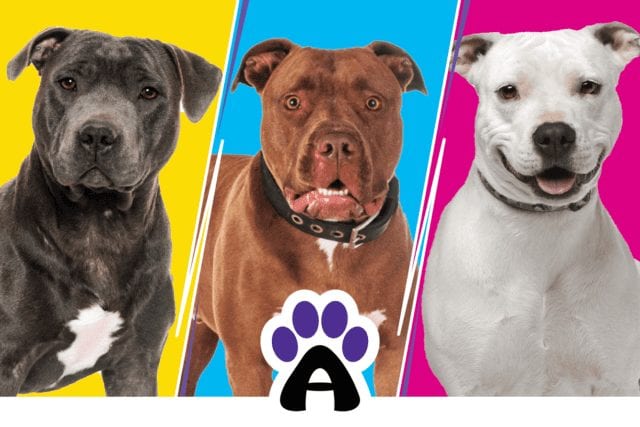Pit bulls are difficult to describe: they are the absolute champions in external variety. This complexity is the result of hundreds of club standards.
In addition, there are many pit bull breeders. But there is one common feature common to all American pit bulls – a short, glossy, hard coat, without an undercoat.
The Pit Bull breed allows any color: from simple monochromatic to complex “artistic”.
There are colors that are prohibited for breeding but are popular with dog owners. But there are those that only specialists can distinguish.
Pitbull types are a fascinating topic full of contradictions and unexpected discoveries.
Genetics of pit bull colors: many nuances
The American Pit Bull Terrier has a short coat with a hard, resilient topcoat. There is no wool in the abdominal area of the pit bull.
The muzzle, paws, and ears are covered with velour hair, which is shorter than the guard hair. The pigmentation of the nose, lips, iris of the pit bull’s eyes is different, as well as the color palette of the coat.
The dog’s coat can be any: the breed allows even chaotic blotches of white and colored spots.
Attention! People who want to acquire a pit bull of an unusual appearance do not fully understand the problems that they may face in the future. There are colors (for example, merle), which are artificial for pit bulls and entail congenital diseases and serious mental disorders.
Before purchasing a cute pitbull puppy, you should find out not only the history of the breed’s origin, its biometric characteristics, but also understand why, for example, buying a luxurious Albanian pit bull or a blue-eyed albino will entail many problems and difficulties.

The Pitbull loci
The pit bull, like other representatives of the canine world, has the same number of color loci – only twelve. There is no dog breed in which all 12 loci are present at the same time.
Pit bulls are no exception. Despite the presence of a wide palette of hair colors, the representatives of the Pit Bull breed lack four loci:
| No. | Loci | Explanations |
|---|---|---|
| one. | M (merle) | Dominant locus: all marbled individuals always have at least one marbled parent. For example, Albanian pit bulls do not. |
| 2. | R | The recession of this locus causes albinism. Today, this locus is present only in Dobermans. |
| In pit bulls, total albinism can be found only occasionally: when the pigment is completely absent both in the wool and in the skin. | ||
| In such dogs, the surfaces of the nose and mucous membranes are flesh-colored, and the iris of the eyes is red or blue. | ||
| 3. | G | Progressive graying of the coat or age-related discoloration. This is the dominant color: it is present in poodles, bobtails and other breeds. |
| Such puppies are born in black or brown colors, over time changing color from nursery to adult. They “change color” in blue or isabella individuals. | ||
| four. | R (roan) | It is the dominant color. In a dominant form, it is found in breeds such as shorthaired hats, drathaars, etc. |
| The roan is similar to the speck, but instead of small areas, only individual hairs of the coat on a white background are pigmented. |
Color is the most important criterion when choosing a pit bulldog. The coat of pit bulls is characterized by heterogeneity, it consists of different types of hair:
- integumentary;
- guard;
- downy.
Important! The color of the dog is transmitted through the guard hair, and the hue is controlled by the pigment. If there is a lack / absence of pigment, then the coat looks colorless. Pit bulls have three main pigment colors: black, brown, yellow.
Pitbull fans should be aware that there is a special red-nosed line of dogs. Its dog handlers refer to the so-called “old family” Old Family Red Nose (red nose).
All red-nosed pit bulls have a red color, copper-red nose, lips, paw pads, and rich brown eyes.
The coloring of the skin and wool is formed by a special pigment – melanin. In nature, there are two types of it:
- eumelanin (these are black and brown colors);
- pheomelanin (these are yellow and orange colors).
The genotype of stained individuals is formed through a variety of “gene sets”. The following genes are responsible for the color of the pit bull’s coat:
- “C” – creates pigmentation of any color;
- “A” – spreads pigmentation along the hairline;
- “B” – creates a black color scheme;
- “C” – partial albinism;
- “B” – forms a brown pigment.
The color of the eyes in representatives of this breed can be any: it is not uncommon for a pit bull with yellow, green, and even blue eyes.
Varieties of colors of pit bulls: any color is available – no restrictions
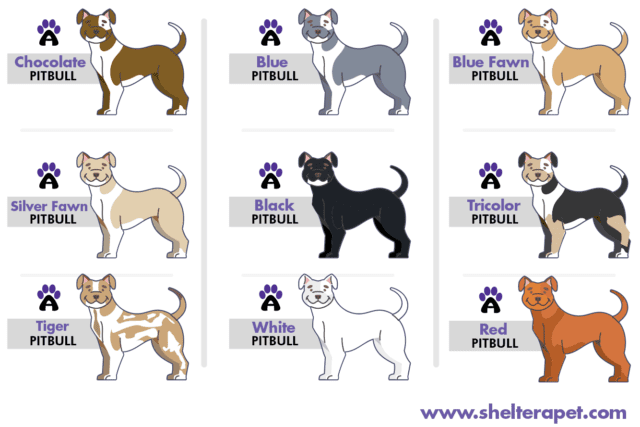
In representatives of the pit bull breed, any eyeliner and iris of the eyes, the color of the nose and ears are possible. But at exhibitions, experts take into account the harmony of the color of individuals as a whole.
Current types of pigmentation in pit bulls:
- solid;
- brindle;
- spotted.
Breed standards assume the following coat color options:
- teak;
- beige;
- gray (blue);
- leopard;
- chocolate;
- white;
- black;
- brindle;
- tricolor;
- merle.
Pitbull standard color
Dog handlers from the International Organization (FCI), despite the fact that pit bulls are the direct ancestors of American Stafford, do not recognize them as a separate breed. Therefore, there are no clear standards for the color of these dogs.
Now there are many colors of pit bulldogs.
Merle
The merle color appeared recently, provoking controversy and criticism from pitbull fans.
Good to know! Merle is a dilute gene. By diluting the color genes, it promotes the synthesis of colors uncharacteristic for pit bulls. The main danger is that pigment cells are formed together with the same set of cells from which the pit bull’s nervous system is formed.
Merle poses the following health risks for Pit Bulls:
- eye diseases;
- hearing loss;
- infertility;
- congenital deformities;
- irreversible immune, mental illness.
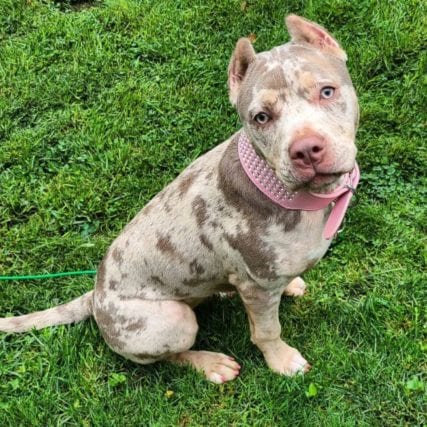
It is forbidden to mate pit bulls – carriers of a similar gene. In their natural environment, individuals of such a rare gorgeous color cannot be born.
The black
Black like night, graceful like a panther, beautiful like a devil – all this directly relates to the “tar” pit bull “Prague”. This dog has an incredibly mystical appearance. Charcoal-colored pit bulls with turquoise eyes look especially attractive.
Pit bulls of black color “vanta” evoke a feeling of fear in people. On this issue, the opinions of experts differ: some claim that black is the standard color for the breed, others that black individuals are prone to aggression and inappropriate behavior.
You should know! Black color does not in any way affect the level of aggressiveness of the animal. It only gives this powerful dog a more frightening look, but nothing more. Black pit bulls are especially popular in the United States.

Black can have a number of basic shades:
- Charcoal black. This color can be combined with a white breast, small marks in the form of a white “tie” or white fingertips are allowed.
- Black and white. Suggests white markings. Their volume should not occupy more than 50% of the dog’s body surface.
- Black and tan. On the background of black wool, there are markings in the form of tan, reddish or light brown in color. The location of the markings: above the eyes, on the muzzle, on the chest, as well as below the paws, under the tail.
- Tricolor. This shade is similar to black and tan, but the dog also has white markings.
- Dark grey. This color is similar to black but differs from it in a more / less pronounced bluish tint.
Tiger
The Tiger color is the most common natural color for pit bulls. This color implies the presence of stripes, abundantly covering the body of the dog. Also, it may not be stripes, but spots.
Pit bulls with such wool are acquired by many dog owners – this is a natural color that guarantees the health of the dog.
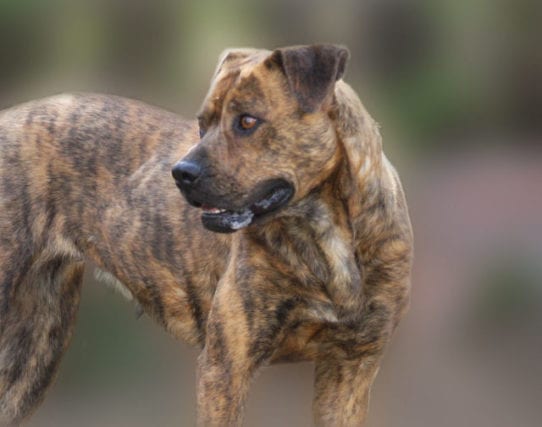
Beige
The beige coat looks spectacular on the powerful representatives of the pit bull breed. This color is recognized by breeders all over the world. This pit bull color can be either solid or with various splashes of white.
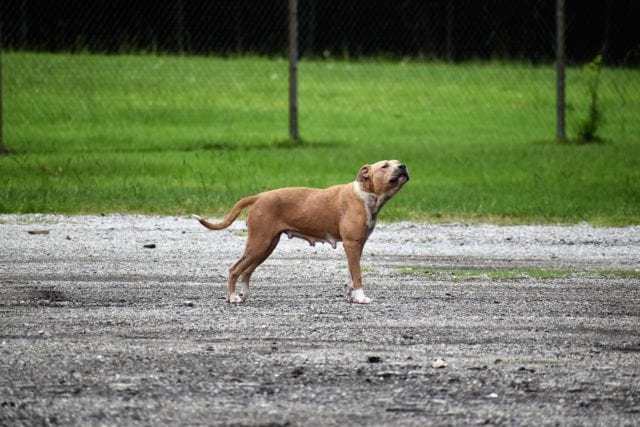
White
Among white individuals, albinos are often found. Albinism refers to a lack of color pigment. These pit bull dogs have two characteristics: these dogs are blue-eyed and with light noses.
These individuals, despite their unique appearance, are recognized by the breeders as “wrong”, so they are not allowed to breed.
Often there are various color variations: from absolutely snow-white to grayish. The presence of a third color is possible – in the form of spots.
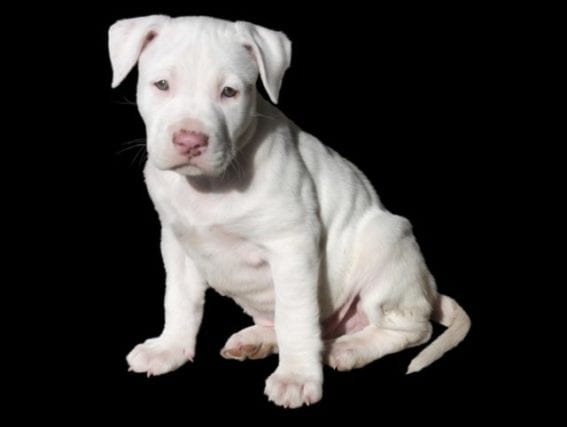
Chocolate
Cynologists identify five options for the chocolate color of pit bulls:
- pure chocolate;
- dark brown chocolate;
- milk chocolate;
- chocolate white;
- chocolate and tan.
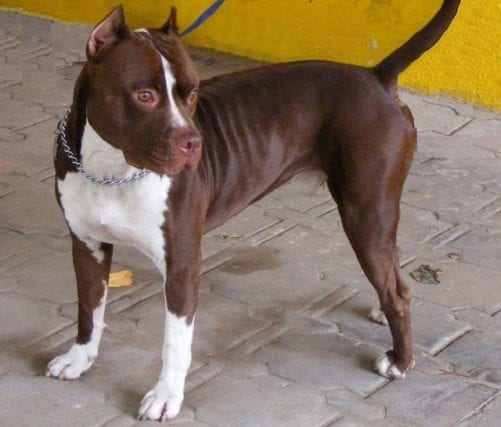
Leopard print
Cynologists refer to leopard-colored individuals as “spotted Albanian pit bulls”. Outwardly, they look like American pit bulls, but they are colored like a leopard.
Such an incredible coloring of pit bulls is obtained under the influence of the merle gene. Therefore, this color is not included in the breed standard, being unsafe for the health of an adult dog. But this does not prevent breeders from actively breeding leopard-colored pit bulls, as they are in great demand by buyers.
Helpful information! Experts believe that such dogs should not be. Titus is a unique representative of the Albanian pit bull. This is the name of the dog, which was specially bred in the USA: it has the appearance of a pit bull, and the color of the color is like that of a leopard
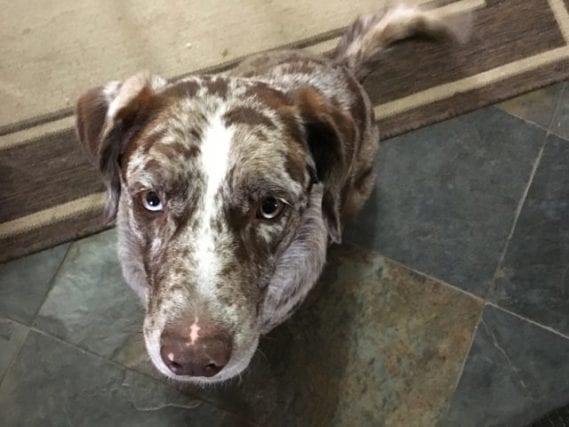
Grey
The gray color scheme also has another name – blue, fawn, or ashy. It is compared to the color of red and red. If these colors are located on the saturation scale, a sequence of the following is obtained:
- pale yellow;
- red (orange);
- red.
The active demand for pit bull puppies of a beautiful blue color has led to a situation when dishonest breeders, realizing the ignorance of their buyers, sell them black puppies under the guise of blue.
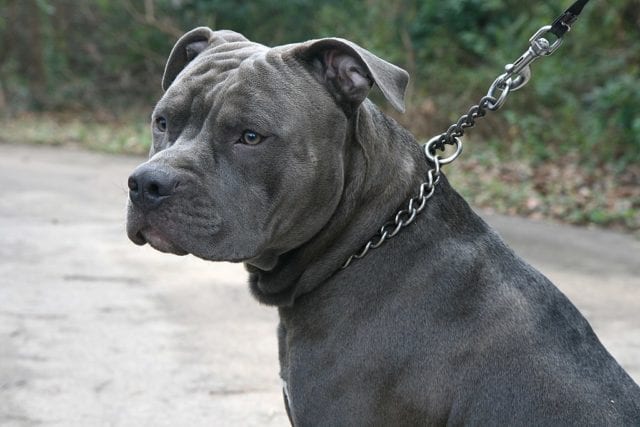
Tricolor
Tricolor pit bulls are considered rare. The triple color combination gives many different color variations: this is the classic tricolor combination (black-white-red), as well as tricolor blue, chocolate.
All these variants of color combinations the breed allows, they are recognized by breeders all over the world.
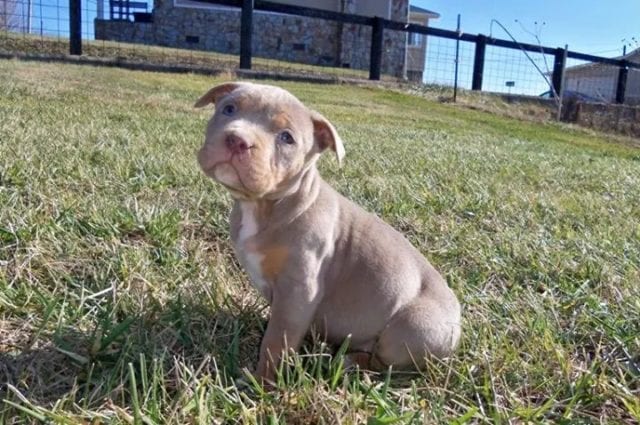
Teak
By teakness, dog handlers mean the presence of small speck-like spots in the pit bull, located on areas of white wool. The main color of such individuals (without white) is mottled.
But you will not be able to see it: it becomes noticeable only against the background of white wool – for example, as it looks like in Dalmatian dogs or in representatives of the English Setter breed.
Attention! The teak (speckled) color of the pit bull and the color of the merle can easily be confused by a person who is not a specialist dog handler.
Pitbull grooming and hygiene
Pit bulls are considered unpretentious dogs that do not require complex care. The main thing is to control the condition of the ears: they should always be clean and dry. Ears need to be treated once a week, as well as brushing the pet.
There is no clear bathing regime for a pit bull: washing occurs as needed. If the dog does not grind his nails on the asphalt in a natural way, they must be trimmed.
Pitbull needs increased activity, so you need to walk with him at least twice a day. This breed of dogs is focused on outdoor games, frequent training.
Helpful tips from the Pit Bull Care Specialists:
- Combing. Since the pit bull is the owner of short hair, it does not require special attention: you just need to comb it out once a week. At the time of active molting of a pit bull, a furminator designed for short-haired individuals should be used.
- Clipping claws. Representatives of the pit bull breed should trim the claws as they grow back. If the pit bull’s claws are grinding on the asphalt, then pruning is not necessary.
- Dental (gum) care. The pit bull needs daily jaws to check for odor, inflammation, and food debris. From puppyhood, a pit bull should be taught to brush teeth and gums with a special soft brush.
- Hygiene of the muzzle. It is necessary to monitor the condition of the pet’s eyes daily, removing secretions with a wet swab. Pitbull ears need special care and should be checked for sulfur deposits and inflammation.
- Checking the anal area. The pit bull requires regular monitoring of the area under the tail for dirt and redness: in representatives of this breed, the anal glands can become inflamed. In this area, it is necessary to trim the excess wool.
Final Thoughts
Today’s breeders receive individuals of a wide variety of colors, with interesting patterns on the coat. The World Cynological Service does not recognize Pit Bulls, but this breed still received a certain standard.
According to them, pit bulls should be distinguished by pronounced muscularity, but be thin. As for the colors, any color is allowed except white and marble. The pit bull’s coat should be smooth, without an undercoat.

